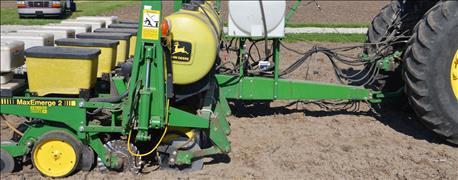
Pete Illingworth is a self-taught mechanic in many ways. He is also one of the crew that gets both research plots and bulk land planted at the Purdue University Throckmorton Ag Research Center near Romney.
One of his specialties is getting the planter in top shape for spring. He allots time each March to going through the planter and making repairs that will increase the odds for better stands in the field. While he works with a six-row planter, the same principles apply no matter what size of planter you have.

READY TO ROLL: The planter is level. The units are checked for wear. Necessary replacements have been made. Pete Illingworth says he’s ready to roll!
Then he spends time in the field early in the planting process making sure he is getting the performance he wants. He also takes advantage of modern conveniences, such as the Precision Planting 20-20 Seed Sense monitor, to gauge how well he is doing.
Here are five keys he follows to achieve good stands.
1. Have the planter ready when it comes to the field.
Illingworth knows what the planter units inside these boxes will do before he ever gets to the field. He tears each unit down and looks for parts that need repairs each year. He also calibrates his units to make sure they are accurate.

READY TO ROLL: This planter unit has been checked out thoroughly, along with every other unit on the planter.
2. Take time to do the little things.
Not everyone wants to get off the planter tractor, grab a level and put it on the unit frames to make sure they are running level. Illingworth took time to do this a year ago. As it turned out, whether the planter ran level or not didn’t make a big difference in 2015 in this trial field. Whether the planter is level largely affects planting depth. Emergence was relatively even no matter what the depth, and there were no yield differences. However, Bob Nielsen, Purdue Extension corn specialist, says there may be a year where it makes a difference

PUT THE LEVEL TO THE METAL: The only way to know if the planter unit is running level is to get out of the cab and use an old-fashioned level to check it.
3. Don’t guess at seeding depth or trust the planter settings
If you think getting off long enough to dig a few seeds in each row and make sure the depth is where you want it is old-fashioned, you might want to think again. Illingworth still believes it’s important to make sure seed is going where you think it is, and is going there uniformly.

DIG AND MEASURE: Take time to see how deep seed is being placed. If you want it three inches deep, make sure every row is placing every seed three inches deep.
4. Know what’s in the bag, and be aware of germination percentage
Some people don’t think reading seed tags is important. Illingworth disagrees. He wants to know what traits the hybrid has so he knows whether to use insecticide as he plants or not. If it doesn’t have below ground rootworm protection, then he will add insecticide. The planter is equipped to do so. He also wants to know about germination and quality of the seed.

TAKE TIME AND READ: It only takes a couple minutes to double-check and make sure you know the traits of the hybrid you’re planting.
5. Plan for a uniform environment around the seed.
Placing seed at the same depth is part of the equation. You may not want the seed to be in moisture. But if some are in moisture, then you want all of them in moisture. You will also want to set closing wheel settings to make sure you aren’t getting too much pressure on the seed, Illingworth says. You don’t want sidewall compaction in the seed zone. Note the lack of sidewall compaction here.

FAVORABLE ENVIRONMENT: Careful digging finds a seed in moisture without sidewall compaction.
About the Author(s)
You May Also Like




